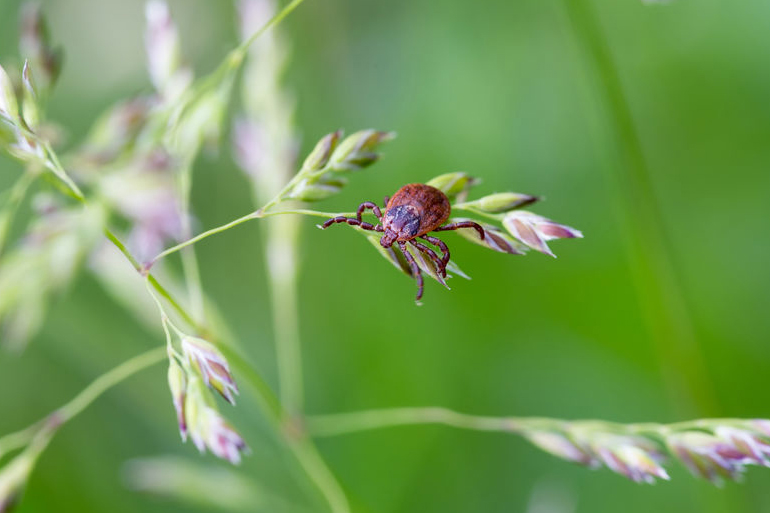COVID-19 Adds New Concerns During Lyme Disease Awareness Month

May is Lyme Disease Awareness Month, making it a perfect time to consider the dangers of the illness in what will be a particularly difficult season, thanks to the coronavirus (COVID-19) pandemic and a particularly heavy tick population. Already hard at work trying to stem the tide at homes around the Twin Forks, East End Tick & Mosquito Control President Brian Kelly shared some thoughts about how Lyme disease could affect COVID-19 patients and the efforts of healthcare providers, as well as some tips for keeping yourself safe from tick-borne diseases this summer.
Even before discussing possible interactions with the COVID-19 virus itself, Kelly points out that social distancing, not going to work and sheltering in place could impact the spread of Lyme disease and other tick-borne illnesses. “People are spending more and more time in their own backyards, and probably this summer, more than ever, people are going to be using their backyards,” he explains, also noting that pandemic-safe activities, such as walking trails and enjoying the outdoors at beaches and parks, increases exposure to ticks. “I don’t know if you’ve driven by any of the local trails in the last few weeks…the Morton [Refuge] preserve, you can’t get another car in the place or any of the trails.”
Because of what he describes as an “extremely mild winter” that allowed ticks to be active whenever temperatures rose above 40°, which was often, Kelly is expecting a very high tick population this summer. “People need to realize that ticks are being found just about everywhere right now,” he continues. “They call it Lyme Disease Awareness Month for a reason—because the ticks during the month of May are bad.”
As for how COVID-19 might impact people with Lyme disease, or vice versa, Kelly doesn’t profess to be a medical expert, but he says it’s hard to get concrete information on the subject because the virus is so new. He worried, however, that the flu-like symptoms both Lyme and coronavirus share could present problems for local doctors attempting to diagnose one disease or the other. “And we don’t want any co-infections. If you have Lyme disease and COVID-19, what’s going to happen then?”
Nobody knows, but it’s a safe bet a patient’s situation would not improve.
“Everybody needs to be careful,” Kelly adds, explaining why he’s getting the word out for Lyme Disease Awareness Month. “The last thing the hospital needs are co-infections with Lyme disease. It couldn’t be good, that’s for sure.” Further, he says a patient suffering from Lyme or both illnesses might not be treated correctly. “You really have to be more diligent this year than ever. Everybody is worried about COVID-19, which you should be, but you also can’t let your guard down with the ticks. It is a big problem out here and we’re finding a ton of ticks emerging from their winter hiding spots right now, and it’s going to be a bad season.”
To help minimize the dangers of ticks, Kelly recommends homeowners get monthly spray applications, adding, “It greatly reduces the tick population on your property, but nothing is 100% when it comes to Mother Nature. There’s no such thing as being 100% tick-free, but monthly applications make a tremendous difference.”
Kelly says East End Tick offers alternatives, such as organic products or installing owl nests—because owls eat the mice, and mice carry lots of ticks. “There are all sorts of ways to do this, but spraying alone doesn’t solve your problem,” he continues, noting that it’s vital to keep one’s property clean of dead leaves, weeds and tall grasses, which ticks love. “That’s where the ticks lay their eggs, on the underside of dead leaves. They like those cool, damp, moist areas, so getting the leaf litter up and getting it into the woods and off your property as early as possible helps sets the stage for what’s going to happen for the rest of the season.”
Above all, Kelly says the most effective solution is using a personal tick repellant and checking for ticks. “If you use a tick repellant when you’re out in the yard, on your sneakers and things, you’re much less likely to get bitten by a tick. And if you check for ticks on a daily basis—maybe once in the morning and once in the afternoon when you shower or are using the bathroom, or just give yourself a once over, you can find a tick before it has a chance to do any damage,” he adds. “They usually need to be on you for 24–36 hours, so if you can find that tick and remove it properly, you’ll be in good shape.”
For more information on East End Tick & Mosquito Control, visit tickcontrol.com.



